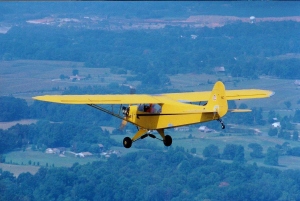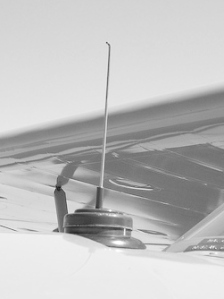Topical Tuesday – Aircraft of the Month
Prologue: Last year I made an abortive attempt to post an “Aircraft of the Month.” It did not continue because of several reasons—or excuses. But the main fault was that I did not really understand, other than the fact that I really like aircraft and flying, why I was trying to write this series. I think I have overcome that flaw. My goal this year is to highlight (1) aircraft that have had a real impact on flying, and in some cases, society, and (2) aircraft that have directly influenced me—many of those you have already met if you have followed my blog.
The aircraft for January fits into both of those categories.
The J-3 Piper Cub
Almost everyone has heard of the “Piper Cub.” The Cub, Piper model J-3, is about as basic as an aircraft can be.

This is actually a near perfect scale model of the original Cub (Great Planes Model Manufacturing Company)
It is a metal frame, covered in fabric with an engine attached to the front, and a few “doodads” added to make it controllable. The result was a plane that was inexpensive, easy to fly, and easy to maintain.
The aircraft has two tandem seats (one behind the other) and a conventional landing gear (i.e., a tail wheel). A key visual characteristic is the fact that the air-cooled engine cylinders protrude from, and are visible outside of the cowl. And Mr Piper may have paraphrased Henry Ford if he said, “You can have any color you like as long as it is bright yellow” (except for the Army!).

Restored Piper J-3 Over East Tennessee (Photograph: Jeff Richmond)
From between 1938 and 1947, Piper Aircraft produce more than 20,000 J-3s. They were built primarily as training aircraft.
The Army asked Piper to produce a military version. The only thing Piper had to do to create the military O-59 or L-4 was to paint it Army olive drab.
The earliest J-3s were powered by a 40 horsepower engine and sold for just over $1,000. Over the years, the power output of the engines increased continuously to 65 HP. In the late 1940s, Piper replaced the J-3 with the PA-11 Cub Special that had a fully enclosed cowl around the engine. The standard Cub Special was equipped with the 65 HP engine, but later production models were offered with a 95 HP engine.
Nearly 80% of all WWII pilots received their initial flight training in a Piper J-3 or the military equivalent, the O-59 and later the L4 Grasshopper (Army) and the NE (Navy).
As World War II was steadily drawing the United States into the battle, the Civilian Pilot Training Program (CPTP) was established and the J-3 was selected as the primary training aircraft for the CPTP program. Later, the military L-4 (designated NE for the Navy) was used on the front lines for reconnaissance, liaison, and ground control.

Restored Piper J-3 Over East Tennessee
L-4s also saw duty in the Korean War. After the war, many J-3s (and retired L-4s) were modified for special purposes such as crop sprayers. Because of their rugged construction, ease of maintenance, economic operation, and ability to operate from fields, pastures, and almost any flat area, they are often used a bush planes.
Production of the J-3 ceased in 1947, but was soon followed by the PA-11 Cub Special, equipped with the 65 HP engine, and offered with a 95 HP engine as an option.
Both the original J-3 as well as the later PA-11 Cubs were easily modified with more powerful engines and used as crop dusters or seaplanes. Most PA-11s were also tail-wheel aircraft, although Piper modified the design for a few with tricycle landing gear.
Personal Experience
In high school I belonged to a Civil Air Patrol squadron. We had a J-3 Piper Cub and a Stinson L-5.
One Sunday afternoon several of us were “hanging out” at the airport. There was a pool table in the ready room, so we were not totally disappointed if we did not get to fly.
One of the senior pilots came in and ask if anyone wanted to go for a flight. My reflexes have always been good and my hand went up before he finished the word “flight.” We were going in the bright yellow J-3 Cub.
Most J-3 cubs had the fuel tank mounted just in front of the windscreen behind the instrument panel. This put the weight of the fuel forward of the center of gravity for the aircraft. To maintain proper aircraft balance, when flying solo, pilots sat the rear seat. Once we had learned to fly the Cub from the front seat (with instructor in the back), the transition to the back seat for solo flight was not difficult. Since the fuel tank was directly in front of the pilot, the fuel gauge was a wire extending through the fuel filler cap, attached to a cork float on the bottom. As the fuel was used, the wire got shorter and shorter. It was an almost fool-proof fuel gauge.
There I was
Before we departed, we topped off the 12-gallon fuel tank, which meant we had enough fuel for two and half hours. The fuel gauge was extended all the way up out of the tank.

The Fuel Gauge is a wire that is attached to a cork that floated on top of the fuel in the tank. As the fuel is used, the cork and the wire move down. (Photo from the CJ2C thecj2apage.com Forum)
We took off and climbed to maybe 500 feet, safely above trees but low enough to get a good view of the ground. Typically, we flew at about 60 mph. The Cub had a top speed of 85 and a normal cruising speed of 75. It would fly along easily at 40 mph.
The pilot let me fly the plane. I practiced smooth turns, climbs, and descents to fine-tune coordination of my hands and feet. It was a bright, sunny day with an absolutely clear sky. Funny how you remember details some time.
We completed a steep turn, and I was feeling pretty good about my performance.
One of the things that all pilots do is to constantly scan outside for other aircraft. As I scanned the horizon, my view crossed over the front of the aircraft. The fuel gauge wire was all the way down on the top of the filler cap—indicating near empty. Trying to not sound alarmed, I pointed this out to the pilot.
Immediately he took the controls and maneuvered the aircraft back toward a nice large pasture over which we had been flying. “We’ll land and check it he said,” about as casually as you would pull over to the side of the road to check a tire.
Since we were soon over the field, even if the engine quit, we would simply glide in for a landing. The engine did not quit, and we made a smooth landing in the grass and shut down the engine.
He got out and checked under the engine and said. “There are no signs of a leak.” He opened the fuel filler cap and checked. “The tank is nearly full,” he said. Then he looked at the cork float. It was fully saturated and had simply sunk to the bottom of the tank.
He replaced the cap, cranked up the engine and I got to make a pasture takeoff.
Some years later I would fly a PA-11 Cub on floats to get my seaplane rating.
I believe if I could have a plane parked on the edge of the field by the house, it would be a bright yellow J-3 Cub.
